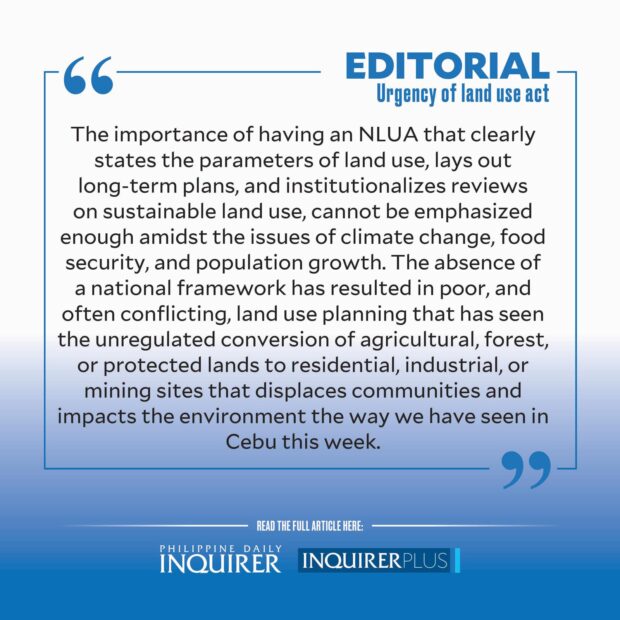The devastating impact of heavy rains in Cebu and Mandaue cities serves as a warning against unregulated and unsustainable urban development. Significant areas in both cities were transformed into waterways, with floods reaching heights of up to two meters. Viral videos on social media depicted a mall’s flooded parking lot and a house being swept away by a landslide. Reports also revealed the collapse of a major street in downtown Cebu City and the collapse of a wall near the Mahiga Creek due to the heavy rains. These catastrophic events were not caused by a typhoon, but rather by week-long torrential rains. Initial investigations indicated that poor drainage systems and extensive development were to blame. Local officials noted that the waters kept rising because they had nowhere to go and flow, as the areas were paved with concrete while existing drainage systems were mostly blocked. Immediate evacuation of affected families and suspension of classes were necessary.
The local government is demanding short- and long-term solutions to address these issues, which are not unique to Cebu but are replicated across the country, particularly in the National Capital Region. However, what makes the floods in Cebu even more significant is their occurrence following the controversial “The Rise at Monterrazas” development project. Spearheaded by social media influencer and engineer Slater Young, this high-end project intends to be built on a mountainside in the Queen City of the South. Critics were quick to highlight the irony of constructing what Young hailed as a “sustainable residential design” while potentially harming the immediate environment. The Philippine Institute for Development Studies (PIDS), the country’s leading think tank, released an article by Lorenzo Makoy that raises questions and concerns about the project’s impact on the mountain’s ecology, hydrology, geology, and the surrounding communities.
The article posited three major questions: How many hectares of trees and mountainside would be demolished to make way for the condos? Were they able to compare their irrigation system and tanks’ rainwater collection capacity to the amount of rainwater that the trees and mountainside could naturally collect, given that roots absorb water, and the soil stores it? Was an environmental impact assessment conducted? Young has assured critics that he has obtained all the necessary permits and that his project will only occupy a small portion at the mountain’s base. They have also conducted a soil profile to ensure the safety of the project site, given that it is made of very hard limestone.
However, the questions raised by PIDS should not only be directed at high-profile projects but also at all development projects, whether planned or underway. We must consider how much of the natural ecosystem is lost when converting land for industrial or residential use. Additionally, measures must be taken to prevent soil erosion and liquefaction for every tree that is felled. It is crucial to understand how these development projects will impact the immediate environment.
This brings us to the urgent need for the approval of the proposed National Land Use Act (NLUA). In a December 2022 column, Inquirer columnist Cielito F. Habito emphasized that the NLUA has been stagnating for nearly three decades. Last May, President Marcos renewed his call for Congress to pass the NLUA, which aims to integrate all mandates and policies regarding land use and protection. Although the President stressed the importance of giving it the “urgent attention it deserves,” he did not mention it in his second State of the Nation Address. The House of Representatives has already passed the bill on third reading, while the Senate is still reviewing the counterpart bill.
Having an NLUA that clearly defines land use parameters, establishes long-term plans, and institutionalizes sustainable land use reviews is paramount, especially in the face of climate change, food security concerns, and population growth. The absence of a national framework has led to inadequate and often conflicting land use planning, resulting in the unregulated conversion of agricultural, forest, or protected lands into residential, industrial, or mining areas, displacing communities and negatively impacting the environment, as seen in Cebu this week. Today, it may be a house in a hazard zone swept away or an area with insufficient drainage turning into a temporary swimming pool. Tomorrow, it could be an entire village, or cities submerged in water, as witnessed during Tropical Storm “Ondoy”. Must things worsen before action is taken? If the Marcos administration truly aims to “Build Better More,” it must actively advocate for the enactment of the NLUA as part of its legacy.
Denial of responsibility! Vigour Times is an automatic aggregator of Global media. In each content, the hyperlink to the primary source is specified. All trademarks belong to their rightful owners, and all materials to their authors. For any complaint, please reach us at – [email protected]. We will take necessary action within 24 hours.


